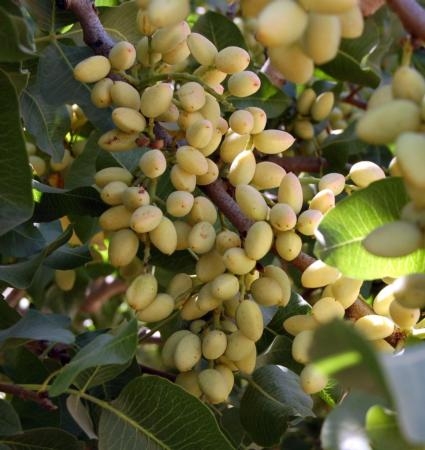
Aflatoxin can form on a wide variety of crops, from corn to cotton to tree nuts. Careful management practices help keep levels low, but still hundreds of thousands of pounds of pistachios are rejected each year due to the presence of aflatoxin.
UC Davis plant pathologist Themis Michailides and his team of researchers at Kearney discovered how to expose pistachio trees to the spores of a beneficial fungus that displaces the fungi that produce aflatoxin. Displacing aflatoxigenic fungi with a beneficial fungus has never before been done in tree crops.
“We’ve gotten great results,” Michailides said. “The reduction in aflatoxin contaminated nuts has been up to 45 percent. We anticipate higher reduction with application of the beneficial fungus for multiple years and on larger acreage.”
The new process was approved by the U.S. Environmental Protection Agency in February and the California Department of Pesticide Regulation in May, in time for 60,000 acres of the 2012 California pistachio crop to receive the innovative treatment.
“This is a big step,” Michailides said. “There will be a tremendous savings to pistachio growers by reducing rejections and the need for resorting nuts before going to market.”
Aflatoxin was discovered in the 1960s when a flock of turkeys in England died after eating contaminated feed. Aflatoxin is produced by certain strains of the fungus Aspergillus flavus, which is commonly found in soil and decaying vegetation. Aflatoxin is a resilient foe. Roasting nuts does not destroy the toxin. Other crops, such as corn and cottonseed used as animal feed, can be treated with ammonia to reduce aflatoxin, however ammonia treatment is not possible for human food, such as tree nut crops.
All shipments of pistachios are tested for aflatoxins, and are rejected in Europe if contamination exceeds 10 parts per billion and in the United States if shipments have more than 15 parts per billion.
The use of beneficial fungi to fight aflatoxin was first discovered and investigated by Peter Cotty, a USDA Agricultural Research Service plant pathologist located in the School of Plant Sciences at the University of Arizona. Cotty’s research focuses on reducing aflatoxin presence in corn and cottonseed. In collaboration with Cotty, Michailides and his colleague Mark Doster, staff research associate in the Michailides lab at Kearney, found that Aspergillus flavus 36 (AF36) can be introduced into an orchard by inoculating “dead” wheat seeds and then dispersing the seeds on the orchard floor. Dew and soil moisture spur the development of harmless spores that colonize pistachios and prevent colonization by toxigenic fungus strains.
The Kearney scientists are continuing their cooperation with USDA’s Cotty as they expand the research to almonds and figs.
“We’re conducting micro-plot experiments with the almond industry at Kearney,” Michailides. “We hope to get an experimental use permit soon to make the treatment available to almond growers.”
Michailides’ aflatoxin research was funded by USDA, the California Pistachio Research Board, the Almond Board of California and a UC Discovery Grant. The research was made possible by the involvement of cooperating pistachio growers who opened their orchards to scientists for conducting AF36 trials.